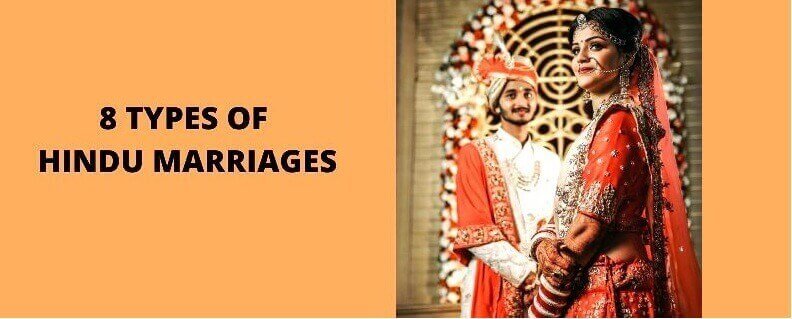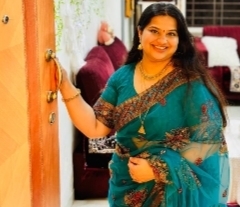
8 Types of Hindu Marriages
The color, the festivity, the rituals, and the food, make marriage ceremonies in India extra special. As we all know People come from all over the world to witness Indian weddings. They simply enjoy our culture, rituals. What makes Indian marriage ceremonies so special is the diversity. The rituals followed in the northern part of India are not the same as in the southern part of India, the east has different kinds of weddings and so does the west. There are different types of marriages in India. Let us understand the different types of marriages practiced in India.
Hinduism mainly includes 16 sacred sanskaras in the entire journey of any human being. Marriage is considered to be the most sacred sanskar among all, because as per our scriptures a human can pursue dharma(responsibility/duties), Arth ( money) and Kama (sex), and ultimately Mokasha through this marital journey.
Hindu marriage harmonizes two individuals (mostly male and female) for ultimate eternity. It also joins two families together. Ancient India was practicing many types of marriages.
The eight types of traditional marriages recognized in Hindu law books are listed below.
- Brahma marriage. ...
- Daiva marriage. ...
- Arsha marriage. ...
- Prajapatya marriage. ...
- Gandharva marriage. ...
- Asura marriage. ...
- Rakshasa marriage. ...
- Paishacha marriage.
1. Brahma Marriage:-
A Brahma marriage is where a boy can get married once he has completed his studenthood or Brahmacharya. When the parents of the boy seek a female, they would consider her family background, but the girl's father would make sure that the boy that wishes to wed his daughter knew Vedas. Asking or expecting dowry from the bridal side is considered to be a sin, in this type of marriage. So Brahma marriage has the most supreme position of the eight types of Hindu matrimony.
2. Daiva Marriage:-
This type of marriage is considered inferior among all types of marriages because it is degrading to womanhood. This is where the woman's family will wait for a specific time to get her wed. If she doesn't get a suitable groom, then she would be married off to places where the family chooses by matchmaking through the priest who duly officiates at a religious ceremony, during its performance. This used to be the practice followed by many Royals in ancient times to forge diplomatic ties with allies and enemies alike.
3. Arsha Marriage:-
An Arsha marriage is where the girl is given in marriage to a sage. The bride used to be given in exchange for some cows. Muni Agastya and Lopamudra got married through Arsha Marriage.
4. Prajapatya Marriage:-
Prajapatya is when a girl's father gives her in marriage to the groom, treating him with respect, and addresses them: 'May both of you perform together with your duties'. Unlike in Brahma marriage, Prajapatya matrimony is where the bride's father goes in search of a groom.
5. Gandharva Marriage: -
The voluntary union of a maiden and her lover on their own is called Gandharva marriage. When it comes to ‘love’ marriage, it is Gandharva marriage that is the most similar. This is where a groom and his bride could wed without their parent's knowledge or sanction. This is how Dushyant married Shakuntala Note that this is not the same as dating. Here the bride and the groom exchange vows in the presence of some person, creature, tree, plant, or deity before any further action.
6. Asura marriage:-
This is matrimony where the groom may not often be compatible with the bride and may even possess some abnormality but either greed or compulsion on the part of the bride's father coupled with the groom's desire and wealth may render it. At all times this type of marriage was considered lowly. In modern times this is unacceptable because it is much like buying a product off the shelf and against common Indian law.
7. Rakshasa marriage –
The groom will force battles with the bride's family, overcome them and carry the bride away to convince her to marry him. Because of its use of force this marriage is considered to be a sin. In modern times also it is a crime. Hence it is known as Rakshas vivah or Rakshas marriage.
8. Paishacha Marriage;-
When a man by stealth seduces a girl who is sleeping, intoxicated, or mentally challenged, it is called Paishacha marriage. This is condemned in the manusmriti as a sinful act. It is considered the most inferior marriage type.
Marriage is an important social institution. Marriages in India are between two families, rather than two individuals It results in a more or less permanent relationship between a man and a woman. Its aim is not merely physical pleasure but spiritual advancement. It is not merely an individual function but has social importance. Its ideals are the fulfillment of Dharma, procreation and It exhibits an integral approach to this social institution.
Aims of the Hindu Marriage
1. Fulfilment of Dharma or religious duties:
According to the Hindu scriptures, marriage is the basis of all religious activities. According to Mahabharata, “wife is the very source of the Purusharthas, not Only of Dharma, Artha, Kama but even of Moksha.
- Procreation:
In the Hindu family, the child is given a very important place. According to Rigveda, the husband accepts the palm of the wife to get a high breed progeny. According to Manu, the chief aim of marriage is procreation.
A lot of these types of marriages are still seen in Hinduism communities today. However, some have been prohibited or are heavily frowned upon. This article has taken a look into the eight different types of Hindu matrimony, but, the most acceptable for Hindu culture would be Brahma.
As society has advanced the Hindu marriage has gone through various changes. Even values attached to it have changed tremendously. Westernization has changed our concepts about marriage. As we all know these days Girls and Boys are highly qualified, Financially Independent and they have their own sets of thinking and priorities which are very difficult to mold. Individuals now are selecting their mates according to their requirements. Elders are playing a passive role in matrimonial search and their opinion or decisions are secondary. But looking at the matrimonial search challenges, many are not getting into matrimonial alliances.
Dear Bride and Grooms, Marriage is the main foundation of Indian Culture. And to maintain a healthy marriage, the relationship between husband and wife, and the relationship between their two families should be strong enough to support each other in their good and bad times. Probably that is the reason why still Brahma Marriage is practiced more in India.
What type of marriage are you looking for?
5th May, 2021







Leave a Comment